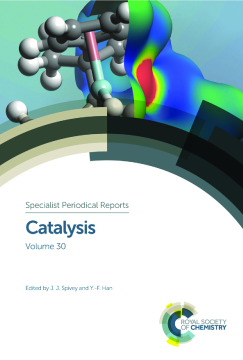
Additional Information
Book Details
Abstract
Catalysts are required for a variety of applications. Industrialists and academics are increasingly challenged to find cost effective and environmentally benign catalysts to use. This volume looks at modern approaches to catalysis and critically reviews the extensive literature on areas such as catalysts derived from waste materials, determining the pore structure of activated carbon by nitrogen gas adsorption and a new tool to explore catalytic reaction mechanisms - the catalytic shock tube. With an emphasis on interdisciplinary content, this book is aimed at catalytic science and engineering research communities.
Table of Contents
| Section Title | Page | Action | Price |
|---|---|---|---|
| Cover | Cover | ||
| Preface | v | ||
| Author biographies | vii | ||
| Contents | xvii | ||
| Catalysts derived from waste materials | 1 | ||
| 1 Introduction | 1 | ||
| 2 Iron containing waste derived catalysts | 4 | ||
| 3 Incineration waste derived catalysts | 7 | ||
| 4 Carbons applied for catalytic purposes derived from waste | 8 | ||
| 5 Base catalysts derived from wastes | 13 | ||
| 6 Miscellaneous wastes | 15 | ||
| 7 Conclusion | 17 | ||
| References | 18 | ||
| Ligand-free subnanometre gold metal clusters and their applications | 21 | ||
| 1 Introduction | 21 | ||
| 2 Synthesis of ligand-free subnanometre gold clusters | 22 | ||
| 3 Characterization of ligand-free subnanometre gold clusters | 28 | ||
| 4 Applications of ligand-free subnanometre gold clusters | 32 | ||
| 5 Conclusions | 37 | ||
| References | 37 | ||
| Determining the pore structure of activated carbon by nitrogen gas adsorption | 41 | ||
| 1 Introduction | 41 | ||
| 2 Nitrogen adsorption | 42 | ||
| 3 Experimental | 51 | ||
| 4 Results and discussion | 51 | ||
| 5 Further analysis | 60 | ||
| Acknowledgements | 61 | ||
| References | 61 | ||
| Catalytic aftertreatment systems for trucks fueled by biofuels – aspects on the impact of fuel quality on catalyst deactivation | 64 | ||
| 1 Introduction | 64 | ||
| 2 Different biofuels and their possible contaminants for catalytic aftertreatment | 67 | ||
| 3 Effect of biofuel contaminants on catalytic aftertreatment components | 77 | ||
| 4 Concluding remarks and outlook | 137 | ||
| Abbreviations | 138 | ||
| Acknowledgement | 139 | ||
| References | 139 | ||
| Deactivation mechanisms in methanol-to-hydrocarbons chemistry | 146 | ||
| 1 Introduction | 146 | ||
| 2 The dual-cycle hydrocarbon pool mechanism | 147 | ||
| 3 Deactivation in methanol-to-hydrocarbons chemistry | 148 | ||
| 4 Outlook | 155 | ||
| References | 155 | ||
| The catalytic shock tube: a new tool to explore catalytic reaction mechanisms | 157 | ||
| 1 Introduction | 157 | ||
| 2 Background and theory | 159 | ||
| 3 Experimental conditions | 170 | ||
| 4 Results | 170 | ||
| 5 Conclusions | 173 | ||
| Acknowledgements | 174 | ||
| References | 174 | ||
| Recent advances on the conversion of glycerol to acrolein, 1,3-propanediol, propanol and propylene using acidic heterogeneous catalysts | 176 | ||
| 1 Introduction | 176 | ||
| 2 Glycerol to other value- added chemicals over heterogeneous acid catalyst | 178 | ||
| 3 Conclusion and outlook | 214 | ||
| Acknowledgements | 215 | ||
| References | 215 |
